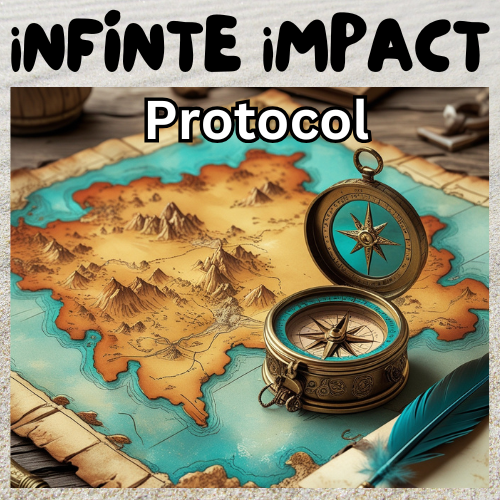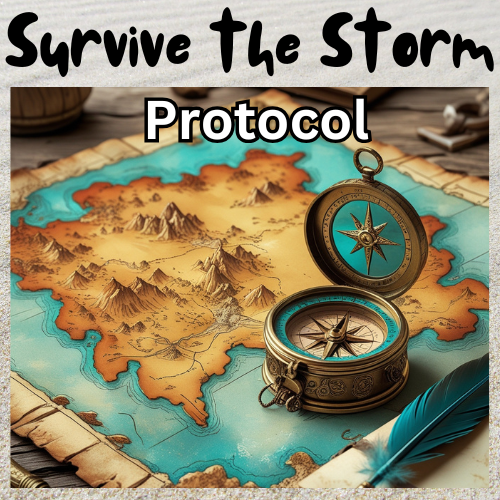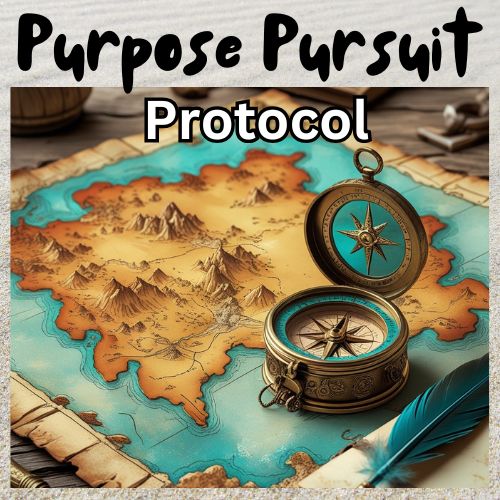Complementary eCourse to Embracing Change – in 10 minutes a day
Module 5: Building a Gratitude and Generosity Legacy
Welcome to Our Final Day Together!
We’ve arrived at the culmination of our journey together. Over these past four days, we’ve explored noticing what’s already good, giving when we feel depleted, finding gratitude in difficult times, and offering the gift of our full attention. Today, we turn to perhaps the most meaningful question: How do we transform these practices from occasional exercises into a lasting legacy that ripples outward far beyond ourselves?
These practices aren’t merely survival techniques for difficult times—they’re foundations for a life of sustained meaning and connection. Let’s meet Elena, whose small act of community gratitude created unexpected ripples throughout her entire neighbourhood.
Module 1
Module 2
Module 3
Module 4
Module 5
Conclusion
Elena’s Story: The Wall That Removed Barriers
Elena Rodriguez hadn’t planned on starting a movement. She was simply trying to manage her own spiralling anxiety during the pandemic lockdown. The constant ping of alarming news alerts, the isolation of working remotely, and the weight of uncertainty about the future had begun manifesting as a tight band of tension across her chest, making each breath feel shallow and insufficient.
Her therapist had suggested a gratitude practice, but Elena found that writing in a private journal wasn’t quite enough. The words felt trapped on the page, as confined as she felt in her small bungalow.
That’s when she remembered the weathered wooden fence separating her front yard from the sidewalk. Years ago, she’d painted a section of it with chalkboard paint, intending to leave notes about garden vegetables for neighbours to harvest. The garden project had never fully materialized, and the chalkboard section had remained largely unused.
On a cool March morning, with dawn light casting long shadows across her front yard and birds creating a tentative soundtrack to the day, Elena took a piece of thick, colourful chalk and wrote across the top of the board: “WHAT ARE YOU GRATEFUL FOR TODAY?”
Beneath it, she wrote: “The sound of rain on my roof last night.”
Then she placed a small bucket of chalk on a shelf beneath the board and went inside, the chalk dust leaving temporary ghostly fingerprints on her coffee mug.
By evening, when Elena ventured out to check her mail, she stopped short at the sight of her chalkboard. At least five different handwritings had appeared:
“My dog’s ridiculous happy dance when I get home.”
“Coffee. Just coffee.”
“FaceTime with my grandson.”
“Frontline workers.”
“That someone put up this board!”
Elena stood there, the unmistakable scent of approaching spring in the air, feeling something loosen in her chest for the first time in weeks. She reached for the blue chalk and added: “Whoever wrote about their dog’s happy dance.”
The next morning, she wiped the board clean with a damp cloth that left her fingers cool and slightly gritty, and wrote a new prompt: “TODAY I’M THANKFUL FOR…”
By afternoon, the board was full again. Throughout the day, Elena caught glimpses through her front window of neighbours pausing at the fence—some she recognized, others she’d never seen before. An elderly man using a walker stopped the longest, carefully writing something before continuing his slow journey down the sidewalk. A woman in scrubs, presumably coming off a hospital shift, scribbled quickly before hurrying on. Two teenage girls giggled as they took turns writing.
That evening, Elena added a second bucket of chalk in different colours.
Within a week, the Gratitude Wall, as it had come to be known in the neighbourhood, had become something of a local landmark. Elena started changing the prompt daily:
“WHO HELPED YOU THIS WEEK?”
“WHAT BEAUTY DID YOU NOTICE TODAY?”
“WHO WOULD YOU LIKE TO THANK RIGHT NOW?”
“WHAT SMALL JOY SURPRISED YOU?”
One rainy April day, Elena heard a knock at her door. Standing on her porch was a woman about her age, holding a clear plastic tarp.
“I’m Mei, from three blocks over,” the woman said, her voice slightly muffled by her mask. “I thought maybe the wall could use some rain protection.” The scent of wet pavement and the gentle patter of raindrops accompanied her words.
Together, they rigged the tarp over the chalkboard section of fence. As they worked, Mei mentioned that she walked by the wall every day on her way to and from the grocery store where she worked.
“It helps,” she said simply, her eyes crinkling above her mask in what Elena assumed was a smile. “Especially after hard shifts.”
That conversation led to an exchange of phone numbers and the beginning of what would become a deep friendship.
By summer, the Gratitude Wall had sparked something unexpected. Elena created a simple neighbourhood email list for “Friends of the Wall.” What began as a way to coordinate wall maintenance evolved into neighbours offering help to one another:
“I’m making a hardware store run today. Need anything?”
“Have extra tomato plants from my garden—first come, first served.”
“Can anyone help Mrs. Abernathy bring in her groceries while her wrist heals?”
When the fall brought cooler temperatures, Elena worried that participation might dwindle. Instead, she woke one morning to find someone had attached a small solar-powered light above the board.
The winter holidays inspired community members to leave small gifts on the shelf beneath the board—handmade cookies wrapped in colourful cellophane that crinkled when touched, knitted scarves soft against the skin, and jars of homemade preserves, all free for anyone who needed them.
On the one-year anniversary of the wall’s creation, Elena organized a block party. Standing in her front yard, the rich aroma of grilled food filling the air and the sound of children’s laughter creating a joyful backdrop, she was struck by how many neighbours she now knew by name—their stories, their challenges, their gifts. People who had lived within blocks of each other for years without speaking were now connected in a web of mutual support and appreciation.
Mei approached her, carrying two paper plates loaded with potluck offerings, the warmth of the food creating small clouds of steam in the cool spring air.
“You know what’s amazing?” Mei said, handing Elena a plate. “My sister started a Gratitude Wall in her neighbourhood in Portland. And her neighbour’s brother did the same thing in Chicago.”
Elena nearly dropped her fork. “Really? I had no idea it had spread.”
“You should check online,” Mei said, the spices from her contribution to the potluck—dumplings made from her grandmother’s recipe—adding to the medley of aromas. “There’s a whole Gratitude Wall movement now. Someone started a website where people can register their walls and share ideas.”
That evening, after the last neighbour had helped stack folding chairs and the remnants of the feast had been packed away in various containers, Elena sat on her porch swing. The gentle rhythmic creaking accompanied her thoughts as she watched fireflies begin their evening dance along the edge of her yard.
What had begun as a personal coping mechanism had transformed an entire community and beyond. Not through grand organization or elaborate planning, but through the simple act of making gratitude visible, shared, and contagious.
As the first stars appeared in the darkening sky, Elena realized she had discovered something fundamental about gratitude and generosity: they were never truly personal possessions but rather flowing currents that gained power when channelled beyond oneself.
The wall itself was just wood and paint. The magic lay in the invitation it extended—to pause, to notice, to appreciate, and ultimately, to connect. In creating a space where gratitude could be expressed communally, Elena had helped weave a fabric of connection that was now strong enough to hold everyone through whatever challenges came next.
On her phone, she started a note titled “Wall Ideas,” already thinking about how they might expand the concept further: perhaps a monthly community meal, a skill-sharing directory, a tool lending library. The possibilities seemed suddenly abundant.
Before going inside, Elena took a piece of chalk from the bucket and wrote on the board: “Grateful for each of you who has made this wall so much more than I ever imagined.”
Her fingers, dusted with chalk that caught the light from the small solar lamp, left their mark on her doorknob—a temporary reminder of the permanent connections that had been formed.
Creating Systems That Sustain: Beyond Feeling to Practice
What Elena discovered speaks to a fundamental truth we explore deeply in the iNFINITE iMPACT Protocol: while gratitude and generosity often begin as individual practices, their true power emerges when we build systems and structures that sustain them beyond momentary feelings or isolated actions.
Research from the field of positive organizational psychology shows that intentionally designed “appreciation architectures”—whether in families, workplaces, or communities—create powerful benefits:
- They bridge individual actions to collective culture. When gratitude and generosity become embedded in shared structures rather than depending solely on individual initiative, they become part of “how we do things here.”
- They create accountability through visibility. Public expressions of appreciation, like Elena’s wall, make gratitude visible and therefore more likely to be sustained and replicated.
- They lower barriers to participation. Well-designed systems make it easier for everyone to participate, not just those naturally inclined toward gratitude practices.
- They build resilience through redundancy. When appreciation doesn’t depend on any single person’s mood or memory, it becomes more resistant to disruption during difficult times—precisely when it’s most needed.
In the Road Map to Resilience Protocol, participants discover that creating these structures before a crisis hits significantly improves their ability to navigate major transitions. And in the iNFINITE iMPACT Protocol, they learn how establishing practices that extend beyond themselves connects them to a larger sense of meaning and contribution.
Legacy Thinking: From Momentary Practice to Lasting Impact
The concept of legacy often brings to mind end-of-life considerations, but in truth, we’re building our legacy each day through the patterns we establish and the ripple effects they create. When we think about gratitude and generosity in terms of legacy, several powerful shifts occur:
- Our time horizon expands. We begin considering how today’s small actions might compound over years and even generations.
- Our focus extends beyond ourselves. We naturally begin thinking about the impact on others, not just personal benefit.
- We become more intentional about systems. Recognizing that our individual practices may not outlast our attention to them, we invest in creating structures that sustain these values.
- We seek to make values visible and transferable. Rather than keeping gratitude private, we look for ways to model and share these practices in ways others can adopt and adapt.
In the iNFINITE iMPACT Protocol, this legacy orientation becomes a powerful source of meaning—connecting daily practices to contributions that outlast our direct involvement.
Your Daily Practice: The Legacy Letter Exercise
Today’s practice invites you to think about gratitude and generosity not just as personal habits but as lasting contributions:
- Create space for reflection. Find a quiet spot where you won’t be interrupted. Perhaps light a candle, play soft instrumental music, or simply sit in a comfortable chair where you can think deeply.
- Complete this sentence stem in writing: “I want to be remembered as someone who…” Let yourself write freely, focusing on the qualities and impacts you hope will outlast you.
- Identify your gratitude and generosity legacy. Ask yourself: “What structures or practices could I create or contribute to that would make appreciation and giving easier for others?” Consider:
- Family rituals that highlight appreciation
- Workplace recognition systems
- Community connection points
- Digital platforms or tools
- Physical spaces that invite reflection
- Educational resources that transfer these skills
- Start small but structurally. Choose one simple “appreciation architecture” you could begin building this week. Perhaps a family gratitude jar, a colleague appreciation channel, a neighbourhood resource exchange, or a personal recognition ritual.
- Invite collaboration. Legacy is rarely built alone. Who might partner with you in creating more lasting structures for gratitude and generosity? Reach out to at least one person to share your vision.
- Set a legacy review date. Mark your calendar for 3 months from today to assess: Has this structure taken root? Is it still dependent on you, or has it begun to sustain itself? What adjustments would help it become more self-perpetuating?
As participants in the Purpose Protocol explore, our deepest sense of meaning often emerges when we connect our values to contributions that extend beyond ourselves—creating ripples that continue long after our direct involvement ends.
Next and Final Installment: The Course Conclusion
Get rid of the nagging emptiness of “Is this all there is?” and step into a life where your accomplishments feel as purposeful, meaningful and fulfilling as they are impressive. This unique mentoring program empowers you to unearth the mission that sets your soul on fire and aligns your life with what truly matters to you—beyond success metrics and societal expectations.

In a world that feels increasingly unstable — politically, economically, emotionally — what will you do when the rug is pulled out from under you? That’s why I created Survive the Storm — a 7-part online course designed to be a lifeline during a life quake. This is your personal survival toolkit for uncertain times — lovingly crafted and packed with practical tools, emotional support, and soul-nourishing insights to help you stay grounded, resilient, and resourceful when everything around you feels like it’s falling apart. Enrol in How to Survive the Storm Protocol, with or without additional mentoring.

The Purpose Pursuit Protocol -a proven, structured process designed and tailor-made specifically for high-achievers who refuse to settle for surface-level success. We strip away the noise, the expectations, the external definitions of “making it,” and get to the core of what actually drives you. The work that electrifies you. The contribution that makes your life matter.


